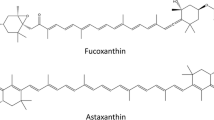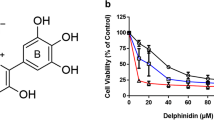Abstract
Increasing numbers of natural products have been found to possess anticancer effects. Nuclear factor erythroid-2-related factor-2 (Nrf2) is a master regulator of the antioxidative stress response, and our previous studies found that epigenetic modification of the Nrf2 gene appears to be a critical mechanism. Salvia miltiorrhiza, a Chinese herbal medicine widely used in Asian countries, has been shown to possess anticancer and antioxidant effects. Tanshinone IIA (TIIA), an active component in S. miltiorrhiza, has been reported to activate Nrf2 pathway. The objective of this study was to investigate the epigenetic regulation of Nrf2 by TIIA in mouse skin epidermal JB6 cells and the functional consequences for cell transformation. TIIA was found to induce antioxidant response element-luciferase and upregulate the mRNA and protein levels of Nrf2 and Nrf2 downstream target genes HO-1 and NQO-1. TIIA decreased the colony formation of JB6 cells by approximately 80%. TIIA decreased the protein levels of DNMT1, DNMT3a, DNMT3b, and HDAC3 and inhibited the enzymatic activity of HDACs. Bisulfite genomic sequencing indicated that TIIA demethylated the first five CpGs in the promoter region of the Nrf2 gene. Chromatin immunoprecipitation assays showed that TIIA treatment increased the recruitment of RNA polymerase II at Nrf2 transcription start site but had limited effects on enrichment of Ac-H3 in Nrf2 promoter. Taken together, our results show that TIIA activates the Nrf2 signaling pathway and induces epigenetic demethylation of the CpGs of Nrf2. The epigenetic reactivation of the Nrf2 signaling pathway by TIIA could potentially contribute to the attenuation of JB6 cellular transformation and anticancer effects.









Similar content being viewed by others
REFERENCES
Cancer facts & figures, American Cancer Society. 2013:1.
Slattery ML, John EM, Torres-Mejia G, Lundgreen A, Lewinger JP, Stern MC, et al. Angiogenesis genes, dietary oxidative balance and breast cancer risk and progression: the Breast Cancer Health Disparities Study. Int J Cancer. 2014;134(3):629–44. doi:10.1002/ijc.28377.
Birch-Machin MA, Russell EV, Latimer JA. Mitochondrial DNA damage as a biomarker for ultraviolet radiation exposure and oxidative stress. Br J Dermatol. 2013;169:9–14. doi:10.1111/bjd.12207.
Finley JW, Kong AN, Hintze KJ, Jeffery EH, Ji LL, Lei XG. Antioxidants in foods: state of the science important to the food industry. J Agric Food Chem. 2011;59(13):6837–46.
Chen Y, Inoyama D, Kong A-NT, Beamer LJ, Hu L. Kinetic analyses of Keap1–Nrf2 interaction and determination of the minimal Nrf2 peptide sequence required for Keap1 binding using surface plasmon resonance. Chem Biol Drug Des. 2011;78(6):1014–21. doi:10.1111/j.1747-0285.2011.01240.x.
Xu C, Huang MT, Shen G, Yuan X, Lin W, Khor TO, et al. Inhibition of 7,12-dimethylbenz(a)anthracene-induced skin tumorigenesis in C57BL/6 mice by sulforaphane is mediated by nuclear factor E2-related factor 2. Cancer Res. 2006;66(16):8293–6. doi:10.1158/0008-5472.CAN-06-0300.
Huang Y, Khor TO, Shu L, Saw CL, Wu TY, Suh N, et al. A γ-tocopherol-rich mixture of tocopherols maintains Nrf2 expression in prostate tumors of TRAMP mice via epigenetic inhibition of CpG methylation. J Nutr. 2012;142(5):818–23.
Yu S, Khor TO, Cheung KL, Li W, Wu TY, Huang Y, et al. Nrf2 expression is regulated by epigenetic mechanisms in prostate cancer of TRAMP mice. PLoS One. 2010;5(1):e8579. doi:10.1371/journal.pone.0008579.
Shu L, Khor TO, Lee JH, Boyanapalli SS, Huang Y, Wu TY, et al. Epigenetic CpG demethylation of the promoter and reactivation of the expression of Neurog1 by curcumin in prostate LNCaP cells. AAPS J. 2011;13(4):606–14.
Stefansson OA, Esteller M. Epigenetic modifications in breast cancer and their role in personalized medicine. Am J Pathol. 2013;183(4):1052–63. doi:10.1016/j.ajpath.2013.04.033.
Khor TO, Huang Y, Wu TY, Shu L, Lee J, Kong AN. Pharmacodynamics of curcumin as DNA hypomethylation agent in restoring the expression of Nrf2 via promoter CpGs demethylation. Biochem Pharmacol. 2011;82(9):1073–8.
Su ZY, Zhang C, Lee JH, Shu L, Wu TY, Khor TO, et al. Requirement and epigenetics re-programming of Nrf2 in suppression of tumor promoter TPA-induced mouse skin cell transformation by sulforaphane. Cancer Prev Res. 2014;7(3):319–29.
Nakao M. Epigenetics: interaction of DNA methylation and chromatin. Gene. 2001;278(1–2):25–31.
Ghoshal K, Datta J, Majumder S, Bai S, Kutay H, Motiwala T, et al. 5-Aza-deoxycytidine induces selective degradation of DNA methyltransferase 1 by a proteasomal pathway that requires the KEN box, bromo-adjacent homology domain, and nuclear localization signal. Mol Cell Biol. 2005;25:4727–41.
Wang Z, Fan J, Liu M, Yeung S, Chang A, Chow MS, et al. Nutraceuticals for prostate cancer chemoprevention: from molecular mechanisms to clinical application. Expert Opin Investig Drugs. 2013;22(12):1613–26. doi:10.1517/13543784.2013.833183.
Agarwal S, Amin K, Jagadeesh S, Baishay G, Rao P, Barua N, et al. Mahanine restores RASSF1A expression by down-regulating DNMT1 and DNMT3B in prostate cancer cells. Mol Cancer. 2013;12(1):99.
Zhou L, Zuo Z, Chow MS. Danshen: an overview of its chemistry, pharmacology, pharmacokinetics, and clinical use. J Clin Pharmacol. 2005;45(12):1345–59.
Zhang HS, Wang SQ. Nrf2 is involved in the effect of tanshinone IIA on intracellular redox status in human aortic smooth muscle cells. Biochem Pharmacol. 2007;73(9):1358–66.
Su ZY, Zhang C, Lee JH, Shu L, Wu TY, Khor TO, et al. Requirement and epigenetics reprogramming of Nrf2 in suppression of tumor promoter TPA-induced mouse skin cell transformation by sulforaphane. Cancer Prev Res (Phila). 2014;7(3):319–29. doi:10.1158/1940-6207.CAPR-13-0313-T.
Shin JW, Ohnishi K, Murakami A, Lee JS, Kundu JK, Na HK, et al. Zerumbone induces heme oxygenase-1 expression in mouse skin and cultured murine epidermal cells through activation of Nrf2. Cancer Prev Res. 2011;4(6):860–70.
Zhang C, Su ZY, Khor TO, Shu L, Kong AN. Sulforaphane enhances Nrf2 expression in prostate cancer TRAMP C1 cells through epigenetic regulation. Biochem Pharmacol. 2013;85(9):1398–404.
Zheng X, Cui XX, Khor TO, Huang Y, Dipaola RS, Goodin S, et al. Inhibitory effect of a γ-tocopherol-rich mixture of tocopherols on the formation and growth of LNCaP prostate tumors in immunodeficient mice. Cancers. 2011;3(4):3762–72.
Su Z-Y, Khor TO, Shu L, Lee JH, Saw CL-L, Wu T-Y, et al. Epigenetic reactivation of Nrf2 in murine prostate cancer TRAMP C1 cells by natural phytochemicals Z-ligustilide and radix Angelica sinensis via promoter CpG demethylation. Chem Res Toxicol. 2013;26(3):477–85. doi:10.1021/tx300524p.
Gong Y, Li Y, Abdolmaleky HM, Li L, Zhou JR. Tanshinones inhibit the growth of breast cancer cells through epigenetic modification of Aurora A expression and function. PLoS One. 2012;7(4):e33656.
Tan HH, Porter AG. p21(WAF1) negatively regulates DNMT1 expression in mammalian cells. Biochem Biophys Res Commun. 2009;382(1):171–6. doi:10.1016/j.bbrc.2009.03.001.
Peng L, Yuan Z, Ling H, Fukasawa K, Robertson K, Olashaw N, et al. SIRT1 deacetylates the DNA methyltransferase 1 (DNMT1) protein and alters its activities. Mol Cell Biol. 2011;31(23):4720–34. doi:10.1128/MCB.06147-11.
Esteve PO, Chang Y, Samaranayake M, Upadhyay AK, Horton JR, Feehery GR, et al. A methylation and phosphorylation switch between an adjacent lysine and serine determines human DNMT1 stability. Nat Struct Mol Biol. 2011;18(1):42–8. doi:10.1038/nsmb.1939.
Robertson KD, Ait-Si-Ali S, Yokochi T, Wade PA, Jones PL, Wolffe AP. DNMT1 forms a complex with Rb, E2F1 and HDAC1 and represses transcription from E2F-responsive promoters. Nat Genet. 2000;25(3):338–42. doi:10.1038/77124.
Tao S, Zheng Y, Lau A, Jaramillo MC, Chau BT, Lantz RC, et al. Tanshinone I activates the Nrf2-dependent antioxidant response and protects against As(III)-induced lung inflammation in vitro and in vivo. Antioxid Redox Signal. 2013;19(14):1647–61. doi:10.1089/ars.2012.5117.
ACKNOWLEDGMENTS
This study was supported by Grant 81102856 from the National Science Foundation of China to Ling Wang and institutional funding to Ah-Ng Tony Kong. The authors thank all the members in Dr. Kong’s lab for their helpful discussion and preparation of this manuscript.
Author information
Authors and Affiliations
Corresponding authors
Additional information
Guest Editors: Ah-Ng Tony Kong and Chi Chen
Ling Wang and Chengyue Zhang contributed equally to this work.
Rights and permissions
About this article
Cite this article
Wang, L., Zhang, C., Guo, Y. et al. Blocking of JB6 Cell Transformation by Tanshinone IIA: Epigenetic Reactivation of Nrf2 Antioxidative Stress Pathway. AAPS J 16, 1214–1225 (2014). https://doi.org/10.1208/s12248-014-9666-8
Received:
Accepted:
Published:
Issue Date:
DOI: https://doi.org/10.1208/s12248-014-9666-8




